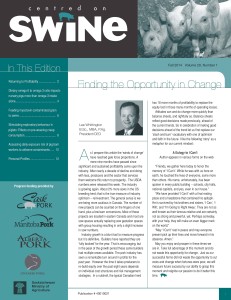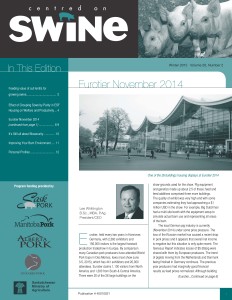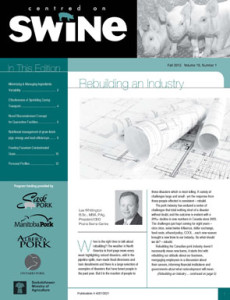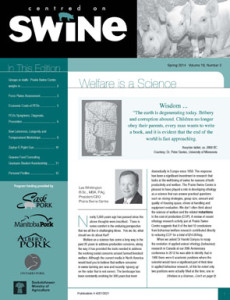Centred on Swine Volume 20
Posted in: Pork Insight Articles, Prairie Swine Centre by admin on November 25, 2014 | No Comments
Individual articles within Centred on Swine can be found in the PorkInsight database.
 |
Volume 20 Number 1
|
 |
Volume 20 Number 2
|
National Sow Housing Conversion Newsletter
Posted in: Pork Insight Articles, Prairie Swine Centre, Press Releases by admin on November 20, 2014 | No Comments
“Barn conversions and new builds for group housing represent a huge cost to the pig industry”, says Dr. Brown. “Our goal is to put together the best possible information, in terms of barn layout, sow management, and cost of construction, to help Canadian producers who are considering this investment.” While countries in the EU have banned stall use except during breeding and early pregnancy (embryo implantation) as of January 2013, the new Canadian Code of Practice encourages the use of group housing systems, but does not totally ban their use. The EU deadline resulted in reports of poor implementation in some countries, with last minute renovations resulting in lost production and poorer welfare in sows. By not having a deadline, Canadian producers can properly consider their options, and chose the right time for them depending on market demands and financing.
The project participants include leading researchers in the science of sow management, and will draw from barn design and management concepts developed in European countries over the past 20 years. “Due to poor market conditions, very little barn construction work has been done in North America over the last 10 years”, says project participant and CEO of the Prairie Swine Centre, Lee Whittington. “By documenting top-notch barn conversions here in Canada, we will develop new expertise and can provide builders and producers with the information they need for successful conversion to group housing.”
In addition to funding from AAFC, the project is supported by provincial pork organizations, Alberta Pork, Sask Pork, the Manitoba Pork Board and Ontario Pork. By taking a consistent and science-based approach on this issue, the Canadian pork industry demonstrates a pro-active approach to sow management that will have long-term benefits to sow welfare and production, while strengthening domestic and export markets.
The full version of the newsletter can be found here.
Can Group-Housed Sows be Raised at Lower Temperatures to Reduce Barn Heating Costs?
Posted in: Pork Insight Articles, Prairie Swine Centre by admin on | No Comments
In this project, an operant mechanism that will allow sows housed in a group system to control their own environmental temperature was developed. The mechanism was configured with a manual control switch that the sows can access and operate, which in turn activated the supplementary room heating system, as well as a localized radiant heater above the location of the switch as an immediate reward. Testing of a prototype system installed in a controlled-environment chamber with two sows showed that the mechanism functioned satisfactorily to allow the sows to control their environmental temperature. Preparations for subsequent tests in group-housed sow gestation rooms to assess overall heating cost savings, associated sow behavior, and optimal dietary requirements when raised at lower temperatures are underway.
It was hypothesized that sows housed in groups can be maintained at lower environmental temperature because the sows have the opportunity to exhibit thermoregulatory behavior such as huddling when the barn temperature is lowered, thereby saving on energy to heat the barn. As such, the objective of this project was to develop a mechanism that will allow group-housed sows to operate the heating system in their airspace and maintain the environment at their preferred temperature. An operant mechanism comprised of a manual control switch that operated the existing supplementary heating system for the sow room as well as a small radiant heater placed above the area of the switch as an immediate feedback reward was developed. Th e underlying principle for this operant mechanism has been successfully implemented in a study to assess the temperature preference of nursery pigs (Bench and Gonyou 2007).
Are My Pigs Eating?
Posted in: Pork Insight Articles, Prairie Swine Centre by admin on November 3, 2014 | No Comments
Recent trials conducted at the Prairie Swine Centre, Inc. have confirmed the importance of feed intake by the piglet immediately post-weaning
and/or consumption of creep feed in the farrowing room. We have also demonstrated that more than half of the piglets may not consume either creep feed, or the starter diet immediately post-weaning. However, in commercial barns, where producers typically measure feed disappearance, piglets are maintained in groups, which makes it difficult to determine which piglets are actually consuming feed. In order to estimate which piglets consume some of the food offered during a specified time period, we have developed a technique where we incorporate non-toxic, food grade dye into the ration. We then used this technique on commercial farms, to demonstrate to participating swine producers, and swine producers in general, that a proportion of pigs in a pen may not be accessing feed during a 24 to 48 hour period. Producers may adopt and use this method periodically on farm to determine if management changes affect the proportion of piglets accessing the feed.
Increasing Creep Feed Intake by Stimulating Exploratory Behaviour using Enrichment
Posted in: Pork Insight Articles, Prairie Swine Centre by admin on October 21, 2014 | No Comments
Weaning is a highly stressful time for piglets, with multiple significant changes occurring simultaneously (change in diet, environment, mixing with unfamiliar piglets). Weight loss and increased cortisol levels have been observed for the first few days aft er weaning, indicating this is a stressful event for piglets. Inadequate food intake in the first two days aft er weaning, in combination with the stress of weaning, decreases piglet performance, resulting in increased disease susceptibility and mortality through changes in metabolic and immune function. Promoting solid feed intake before weaning by provision of creep feed familiarizes the piglets with solid food. Piglets that consume creep show better feed intake and improved growth rate in the critical weaning and post-weaning period. However, previous work conducted at the Prairie Swine Centre shows that the amount of creep feed consumed is oft en very low, and a high number of piglets fail to eat creep. Nursery_pigs_feeding-2 It is important to identify convenient and effective ways of increasing the volume and consistency of creep feed consumption by piglets. Previous research by others has determined that the amount of creep consumed by piglets can be increased by provision of a specially designed feeder that encourages exploratory interaction around the feeder. It is known that piglets raised outdoors are quick to consume starter feed and will oft en ingest soil and plant material while exploring their environment. However, piglets reared indoors do not have the same opportunity for exploration. This study builds upon current knowledge to investigate the effects of provision of environmental enrichment within the farrowing pen and nursery on exploratory behaviour, frequency of visits to the creep feeder, creep consumption and piglet growth rate. If simple enrichment can increase creep feed consumption in piglets this could result in reduced stress at weaning and better growth in the post-weaning period.
Groups or stalls: Prairie Swine Centre weighs in
Posted in: Pork Insight Articles, Prairie Swine Centre, Welfare by admin on May 9, 2014 | No Comments
“Gestation stalls” — arguably no two words have become a greater lightning rod for controversy and passionate debate from many sides around the issue of animal welfare in livestock production. But no matter the viewpoint one element that can be consistently relied upon to cut through the emotion and support informed and productive discussion is the science.
The Prairie Swine Centre is among the latest to add valuable scientific perspective to the conversation, with the release of a scientific review of the “group or stalls” question led by researchers Dr. Jennifer Brown and Dr. Yolande Seddon.
Welfare is a Science
Posted in: Pork Insight Articles, Prairie Swine Centre, Welfare by admin on April 28, 2014 | No Comments
Animal welfare in swine farming is a growing field, and studies are ongoing on topics such as group size and mixing, housing, and equipment use. Behavior and research studies don’t just benefit the animals, it has been shown that the conclusion of the majority of the studies can also contribute to reduced cost of production. A National Chair in Swine Welfare was proposed, and funding is being raised to support further ethology studies.
Centred on Swine Volume 19
Posted in: Pork Insight Articles, Prairie Swine Centre by admin on March 6, 2014 | No Comments
Individual articles in these issues of Centred on Swine are located in our PorkInsight Database.
- Minimizing & Managing Ingredients Variability
- Effectiveness of Sprinkling During Transport
- Novel Biocontainment Concept for Quarantine Facilities
- Nutritional management of grow-finish pigs: energy and feed efficiencyn
- Feeding Fusarium Contaminated Grain
- Groups or stalls: Prairie Swine Centre weighs in
- Force Plates Assessment
- Economic Costs of PEDv
- PEDv Symptoms, Diagnosis, Prevention
- Sow Lameness, Longevity and Temperament Workshops
- Zephyr-E Piglet Gun
- Gowans Feed Consulting Graduate Student Assistantship
Sow Lameness, Longevity & Temperament Workshops – October 8, 9 & 23
Posted in: Pork Insight Articles, Prairie Swine Centre, Press Releases by admin on September 30, 2013 | No Comments
Sow Lameness, Longevity & Temperament Workshops
We would like to invite you to a workshop dedicated to those involved in the breeding and selection of swine for the future. This workshop provides the latest research into sow lameness, longevity, and temperament and how it can positively impact your selection strategy.
There will be three workshops held throughout Canada.
Tuesday, October 8 – Stratford, Ontario – Arden Park Hotel
Wednesday, October 9 – Levis, Quebec – Hôtel L’Oiselière de Lévis,
Wednesday, October 23 – Winnipeg, Manitoba – Farm and Food Discovery Centre, University of Manitoba
To view the full agenda please follow the link below.
Sow Lameness, Longevity and Temperament Workshop
For more information, or to register for the workshops, please contact Helen Thoday at Prairie Swine Centre.
National Sow Housing Conversion Project
Posted in: Pork Insight Articles, Prairie Swine Centre, Welfare by admin on May 13, 2013 | No Comments
The use of stall housing for gestating sows has come under criticism for being too restrictive and failing to provide adequately for the welfare of sows. From 1st January 2013, a legislated ban was implemented in the EU, banning the use of sow stalls from 28 days post breeding. In 2007, the largest pork producers in the USA and Canada pledged to transition their sow housing to group systems over the next 10 years. Now, increasing numbers of food retailers, including Tim Hortons, Burger King and McDonalds, have pledged to source pork from producers who have developed plans for conversion to group housing. In addition the
supermarket chains Safeway and Costco recently announced plans to develop a stall-free pork supply chain. Consequently, the Canadian pork industry is under increasing pressure to convert existing gestation stall housing for its 1.3 million sows to group systems.











